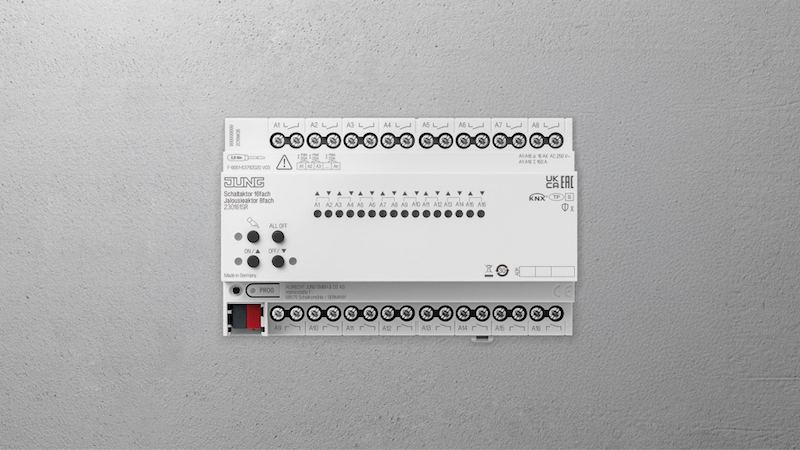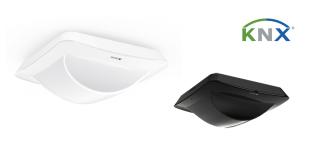The KNX switching and blinds actuators from JUNG offer a powerful and flexible solution for controlling lighting, shading and electrical loads in building automation. Developed for professional insertion in residential and commercial buildings, the actuators are characterised by precise control, high reliability and simple integration into existing KNX systems. Thanks to sophisticated technology and flexible programming, complex scenarios and automations can be realised efficiently – for more comfort, energy efficiency and security in the building.

The switch actuators from JUNG enable the switching on and off of electrical loads such as lighting, sockets, electric heaters and ventilation systems. The bistable relays ensure that the switching state is maintained even in the event of a power failure, which increases operational safety. The blinds actuators precisely control shutters, blinds, awnings and curtains. They enable accurate slat adjusting and end position control, ensuring convenient and energy-efficient shading.
JUNG has equipped the KNX switching and blinds actuators with several new functions that further optimise control. The new heartbeat function is used for device monitoring in the KNX network. The actuator sends status messages to the central control at regular intervals, allowing failures to be recognised and rectified at an early stage. Another new feature is the automatic ventilation position, which now distinguishes between day-time and night-time operation. During the day, the blind ensures optimum air circulation and daylight utilisation, while at night the position is adjusted for privacy and thermal insulation.
The door contact lock prevents the blinds from being lowered or adjusted automatically as long as a door is open. This increases security and prevents malfunctions, especially when patio or balcony doors are open. The new twilight position automatically adjusts the blinds to the ambient brightness by lowering the blinds when twilight sets in to guarantee privacy and stabilise the room temperature. The priority of the twilight function has been adjusted: It now has the same priority as direct operation, which avoids conflicts with manual commands.
The safety functions have also been optimised. After the end of an active safety function (e.g. wind or rain alarm), short time telegrams are no longer tracked, thus avoiding unwanted readjustments. The extended disabling functions can now be applied specifically to individual channels. The current disable status is indicated directly in the KNX system via a feedback object, which makes diagnosis and maintenance easier. The operating hours counter has also been optimised: Multiple trips to the end position without actually reaching the end position are now counted correctly. This warrants a more precise recording of operating hours and simplifies maintenance planning.
Another important innovation concerns the logic module. The threshold values of the limit value switch can now also be specified via separate objects – previously this was only programmable as a constant value. This enables dynamic adaptation to changing conditions and increases programming flexibility.
Commissioning and parameterisation of the actuators is carried out via the ETS (Engineering Tool Software). The actuators support extensive functions such as timer functions, scene control, logic functions and priority control. Time-dependent controls are also possible, as is linking with weather data, presence detectors and brightness sensors. Thanks to the integration into visualisation systems, the actuators can be operated centrally via touch panels, apps or voice control.
The application possibilities of the JUNG KNX switching and blinds actuators are versatile. In residential buildings, they ensure automatic control of the blinds per daylight and weather conditions. The door contact block prevents malfunctions when patio doors are open. The heartbeat function ensures reliable ready status and facilitates fault diagnosis. In office buildings, precise control of the blinds enables non-glare use of daylight. The automatic twilight position ensures an optimum balance between privacy and light incidence, while the central control and heartbeat function increase operational reliability. The actuators also offer advantages in hotels: they control lighting and blinds in public areas and adapt the blinds to day-time and night-time operation to save energy. The door contact block prevents malfunctions and increases comfort for guests.
The JUNG KNX switching and blinds actuators offer professionals a reliable and flexible solution for building automation. The new functions such as the heartbeat function, the automatic ventilation position and the door contact block ensure even more efficiency and comfort. The revised priority control and the extended disabling functions improve control and increase operational safety. Thanks to the precise control, the robust design and the simple programming, the JUNG KNX actuators are the ideal choice for demanding residential and commercial projects.












